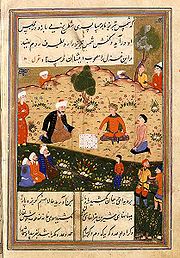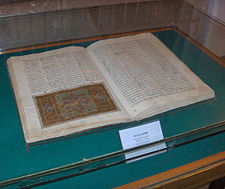
Diwan-e Shams-e Tabriz-i
Encyclopedia

Tabriz
Tabriz is the fourth largest city and one of the historical capitals of Iran and the capital of East Azerbaijan Province. Situated at an altitude of 1,350 meters at the junction of the Quri River and Aji River, it was the second largest city in Iran until the late 1960s, one of its former...
) or Dīvān-e Šhams is one of Mawlānā Jalāl ad-Dīn Muhammad Balkhi's masterpieces. A collection of lyric poems that contains more than 40,000 verses, it is written in the New Persian language and is considered one of the greatest works of Persian literature
Persian literature
Persian literature spans two-and-a-half millennia, though much of the pre-Islamic material has been lost. Its sources have been within historical Persia including present-day Iran as well as regions of Central Asia where the Persian language has historically been the national language...
.
Dīvān-e Kabīr ("the great divan") contains Rumi's poems in several different styles of Eastern-Islamic poetry (e.g. odes, eulogies, quatrains, etc). Although most of the poems are in New Persian, there are also some in Arabic
Arabic language
Arabic is a name applied to the descendants of the Classical Arabic language of the 6th century AD, used most prominently in the Quran, the Islamic Holy Book...
, and a small number of mixed Persian/Greek poems. Dīvān-e Šhams-e Tabrīzī is named in honour of Rumi's spiritual teacher and friend Šhams of Tabrīz
Shams Tabrizi
Shams-i-Tabrīzī or Shams al-Din Mohammad was a Persian Muslim, who is credited as the spiritual instructor of Mewlānā Jalāl ad-Dīn Muhammad Balkhi, also known as Rumi and is referenced with great reverence in Rumi’s poetic collection, in particular Diwan-i Shams-i Tabrīzī...
.


